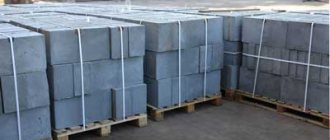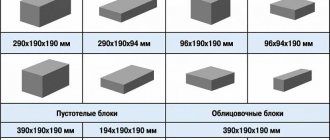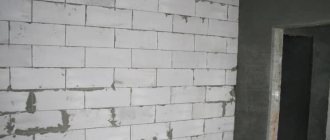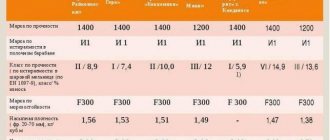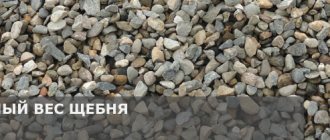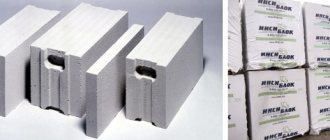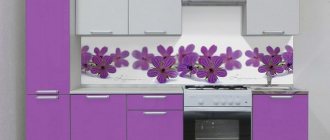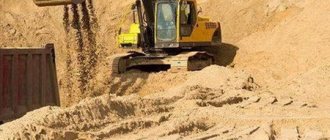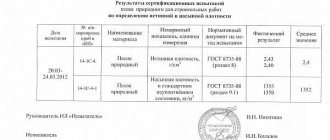How many foam blocks are in a cube if the block dimensions are 200 300 600 mm
In the construction of country houses, foam concrete blocks have become widespread, which has a number of advantages compared to brick. Foam concrete has lightness, strength, good thermal insulation properties, and is easy to process. Often when building a house from such material, questions arise:
- How many blocks will be used to build a house?
- How many foam blocks are in 1 cube?
- What will be the material consumption?
Why do you need to know the quantity?
Gas blocks are sold in cubic meters. Situations often arise when foam concrete blocks need to be counted not in cubes, but in pieces, since counting the quantity in pieces is more convenient when calculating construction estimates.
Knowing the dimensions of an aerated concrete block, you can determine the number of foam blocks in 1 m3 and the cost of one block. By measuring the dimensions of a stack of gas blocks installed on a pallet, you can determine the number of foam blocks in the pallet. This makes it possible to determine the amount of material in cubes required for the construction of a garage, house, service station, or office building.
What is the price of gas blocks with quadrature calculation
As a rule, gas blocks are not sold with quadrature calculations. You can buy aerated concrete individually or in pallets. How many gas blocks are placed on a pallet depends on their size.
Amount of aerated concrete on a standard pallet:
- 600x300x200 - 50 pcs or 1.8 m³;
- 600x200x200 - 75 pcs or 1.68 m³.
Knowing the area of the masonry (length x height of the walls) and how many aerated concrete blocks are in 1 square meter, you can easily calculate the required number of pallets. To calculate the cost of an aerated block for construction, the price of 1 pallet should be multiplied by their number.
Calculation of quantity per cube
The industry produces gas blocks of various sizes. You need to calculate how many pieces of foam concrete are in a cube if the block dimensions are 200, 300, 600 mm. Volume of one aerated concrete block: 0.2 0.3 0.6 = 0.036 m 3
Let's find out how many pieces of foam concrete are in a cube: 1 / 0.036 = 27 pieces.
The same method is used to calculate the number of foam blocks in a cube for its other standard sizes. Let's make a calculation for an aerated concrete block with side dimensions of 200 400 600 mm. Find the volume of one gas block: 0.2 0.4 0.6 = 0.048 m 3
Now we find how many foam blocks are in 1 m3: 1 / 0.048 = 20 pieces.
Calculation of quantity on a pallet
For more convenient loading and unloading of building materials, they are packaged and secured on pallets that are transported by freight. Typically, packages containing 1 cubic meter of material are formed on pallets for transporting aerated blocks. Depending on the type of pallets, this value may vary up or down. When ordering aerated blocks on pallets, their quantity is agreed upon in advance.
In order to avoid questions regarding the amount of material after unloading, you can determine it by the size of the package.
Example
On the pallet there is a package of gas blocks, which has dimensions of 1.2 1 0.3 m. You need to find out how many foam blocks are in one pallet if their dimensions are 200 300 600 mm. To do this, we calculate the volume of the package: 1.2 1 0.3 = 1.08 m 3. We divide the value of this volume by the volume of one block, which has already been calculated. 1.08 / 0.036 = 30 pieces. In this way, you can determine the number of foam blocks in a pallet for other block sizes by measuring the dimensions of the package.
What determines the cost of aerated concrete blocks?
Currently, durable but lightweight aerated concrete blocks are used in construction along with foam concrete and other block stones. The cost of raw materials consists of several factors :
- production technology;
- density;
- degree;
- shape and size;
- other characteristics.
Aerated concrete blocks can be produced either with or without autoclave curing. The autoclave curing method gives better results, but is more expensive. The non-autoclave curing method increases the cost of aerated concrete. The non-autoclave method involves solidifying a solution with additives in a special form in air, sometimes using the scalding method. The price of such raw materials will be significantly lower.
Density is another factor that affects the cost per cubic meter of blocks. The higher the density of the blocks, the worse their thermal conductivity.
The material type is in the first and second . These classes refer to blocks made of autoclaved aerated concrete and are divided according to the principle of maximum deviation from dimensions, shape, weight, volume and other indicators.
The first type can be laid using glue - it will be more expensive, and the second type will be cheaper, but it does not have an ideal geometry, so it can only be laid using mortar.
Important ! The price of aerated concrete blocks of non-standard shapes and sizes, for example, u-blocks, will be more expensive than the cost of standard size wall stone.
Frost resistance also affects the price. also affect frost resistance, fire resistance, mold resistance, etc. . To avoid such troubles during the operation of the house, the manufacturer of aerated blocks adds special elements to the concrete solution, which increases the final price of the material.
Average prices by size.
To understand how much money you will have to spend on purchasing material, you can look at the table. Here is the average cost of aerated blocks in Russia, taking into account the size, shape and brand of stone.
| Name | Dimensions, mm | Density, D | Price for 1 piece, RUB | Price per 1 sq.m, RUB | Price per 1 cubic meter, RUB |
| Straight block | 200x300x600 (20x30x60) | 400 | 120 | 660 | 3320 |
| 500 | 125 | 680 | 3460 | ||
| 600 | 130 | 715 | 3600 | ||
| 600x250x250 | 400 | 100 | 660 | 2660 | |
| 500 | 118 | 770 | 3138 | ||
| 600 | 130 | 850 | 3450 | ||
| 100x250x600 | 400 | 43 | 280 | 2860 | |
| 500 | 50 | 330 | 3330 | ||
| 600 | 56 | 370 | 3730 | ||
| 200x400x600 | 400 | 130 | 540 | 2700 | |
| 500 | 150 | 620 | 3100 | ||
| 600 | 170 | 700 | 3500 | ||
| 250x300x600 | 400 | 120 | 840 | 2660 | |
| 500 | 140 | 980 | 3110 | ||
| 600 | 160 | 1120 | 3550 | ||
| 600x400x300 | 400 | 130 | 540 | 2100 | |
| 500 | 150 | 620 | 3000 | ||
| 600 | 175 | 730 | 3480 | ||
| U-shaped | 500x200x250 | 500 | 220 | 1760 | 8800 |
| 500x300x250 | 276 | 1830 | 7340 | ||
| 500x400x250 | 368 | 1840 | 7360 | ||
| 500x300x200 | 261 | 1740 | 8690 |
Aerated blocks are sold in stores and factories individually, by square meters or on pallets. On average, one pallet contains one cubic meter of material.
As for the sizes that are not the most popular, the average price for a cube of aerated concrete blocks 600x400x250 mm D500 (D500) will be 3100 rubles, for blocks 600x200x250 mm - 3900 rubles per cubic meter, 625x250x100 - 4300 rubles per cubic meter.
Here's what aerated concrete blocks of different sizes look like in the photograph:
An example of calculating the amount of aerated concrete using an online calculator can be seen in the video:
Determining the weight of foam concrete in a cube
When designing a house, determining the load on the foundation plays an important role. Depending on the magnitude of the load, the type of foundation, its design, and depth are determined. To determine the load on the foundation, you need to know how much a cube of foam block weighs. By calculating the number of cubes needed to build a house and multiplying it by the weight of 1 cube of foam block, we get the load acting on the foundation.
The weight of foam concrete blocks depends on the ratio of sand, cement, and the degree of foaming. The block material is marked with the symbol D, which characterizes the density of the foam block material. If the packaging says D300, this means that one cube of this foam concrete weighs 300 kg. When constructing structures from foam concrete blocks, the foam concrete grade D600 is used.
Each standard size of foam block has its own weight. So, for example, a block with side dimensions of 200 300 600 mm has a weight of 22 kg. Since the blocks are made of the same material, the weight of one cube for all sizes will be approximately the same. It is 580 – 680 kg. The variation in the weight of 1 cubic meter of material is explained by the fact that foam concrete is able to absorb moisture, due to which the weight of the blocks can change.
What is more profitable to buy - ready-made mixture or blocks
In general, the selling price of a building material largely depends on its type in which it comes to the market: sellers offer to buy both ready-made blocks and a mixture. To find out how much 1 cubic meter of foam block costs, let's look at its two states mentioned above - liquid and solid.
Construction of structures made of foam concrete
When purchasing a solution, you need to prepare the construction site in advance. Foam concrete is convenient to use for pouring construction surfaces, leveling floors, various types of roofs, as well as for erecting monolithic structures.
As for ready-made foam blocks, they are more convenient for storage and transportation. Due to the fact that foam concrete is measured in cubes, you need to know how many “bricks” are contained in one cube .
Structure – porous concrete is light but durable (see photo)
Note! The number of blocks in one cube directly depends on the size of one unit of goods.
Note! Some of the manufacturers and sellers indicate prices per piece. For example, a D 600 brand block costs 90 rubles per unit.
Blocks vary in both size and quality
If we talk about foam blocks and mortar in general, then this product is presented in a fairly wide range. Many companies offer the buyer various brands of finished products and raw materials that are suitable for full-scale construction work. On average in Russia, a cube of foam blocks costs about 3000-3200 rubles (the price may change in one direction or another depending on the quality of the material).
Buyer Recommendations:
- Please note that when purchasing this material, you should take into account that basically all prices are indicated in cubes + pallet.
- Also, the number of blocks on a pallet directly depends on the packaging density.
- The pallet itself (in most cases) has a standard size of 1x1.2 m. Their cost is automatically included in the price of the building material, and if you decide to return them to the seller, the manufacturer will compensate their full cost.
Attention! After you empty the pallet, you can safely return the pallet to the manufacturer (as a rule, the price of one unit is at least 180 rubles).
- Also, you should know that the cost of raw materials will be calculated at the wholesale price when purchasing quantities of 25 m³ or more.
- The material is sold in foam blocks in cubes (the price includes delivery). What is noteworthy is that the weight of one block is approximately 23 kg, which is essentially 1.5 times less than that of a brick.
If you are building a house with your own hands, then it is better to order blocks in advance - the building material must stand for several days in order to gain its working strength.
Calculation of the number of gas blocks in the house
When building walls made of foam concrete, it may be necessary to calculate how many squares are in a cube of foam concrete. The wall can be laid out with one or two rows of foam blocks. Let's calculate the number of square meters per cube for a wall 200 mm thick made of foam concrete blocks 200 300 600 mm. Side surface area of the gas block: 0.3 0.6 = 0.18 m2.
One cube contains 27 foam concrete products. Multiply the side surface area of the block by 27: 0.18 27 = 4.86 m2
For a wall made of two rows of foam concrete, the wall area will be reduced by 2 times. 4.86 / 2 =2.43 m2.
The number of square meters per cube for different sizes of foam block can be determined in a similar way.
Suppose you need to find out how many cubes of foam blocks are needed for a house 10 by 10 m. The average height of walls in the construction of private households is taken to be 2.8 m. The area of one wall is: 2.8 10 = 28 m2
The masonry is carried out in 2 rows with aerated blocks 200 300 600 mm. To determine the number of cubes per wall, divide the area of the wall by the area of the foam blocks for one cube. 28 / 2.43 = 11.52 cubic meters.
We multiply the result by 4. 11.52 4 = 46.08 m 3
Nuances
- When building a two-story house, it should be taken into account that the load on the lower rows of the foam block will increase by 2 times, so it is better to build the walls of such a house from gas blocks with a width of 240 mm.
- When designing a house, the drawings indicate door and window openings, which can have different sizes, and their number can also be different. Therefore, calculations taking these factors into account are not presented here. You can calculate the number of gas blocks by knowing the area of the openings and using the tips given in the article.
Information on the purpose of the calculator
Online calculator for aerated concrete blocks
designed to perform calculations of building materials necessary for the construction of walls of houses, garages, utility and other premises. The calculations can take into account the dimensions of the building's gables, door and window openings, as well as related materials, such as mortar and masonry mesh. Be careful when filling out the data, pay special attention to the units of measurement.
When filling out the data, pay attention to the additional information with the Additional information sign
Aerated concrete blocks are one of the types of cellular concrete, with air pores evenly distributed throughout the volume. The more evenly distributed such pores are, the higher the quality of the concrete itself.
The production of aerated concrete in a factory is a rather complex process. In addition to cement and sand, chemical gas-forming additives are used in production, the amount of which must be calculated with very high accuracy. After all the components are mixed, the whole mass of aerated concrete is poured into special forms, in which it increases in volume due to the release of gases.
The main feature of the production of cellular concrete is the hardening of poured concrete under pressure in special autoclave chambers. This is necessary so that the air pores are distributed evenly throughout the entire volume. The production of high-quality aerated concrete without such chambers is impossible. After gaining the required strength, the entire array is cut into blocks of the required sizes.
Before purchasing aerated concrete blocks, you need to calculate their quantity as accurately as possible using a calculator so that you do not have to overpay for excess material.
Just like other types of blocks, aerated concrete blocks are divided according to density into:
- structural
- structural and thermal insulation
- thermal insulation
- for the construction of load-bearing walls
- for the construction of load-bearing walls of low-rise buildings
- for the construction of self-supporting walls
Due to their characteristics, such as light weight, good thermal insulation, ease of machining, aerated concrete blocks are a very popular building material, and continue to rapidly gain popularity. But do not forget that good thermal insulation of this material is achieved only if all the rules of construction from aerated concrete blocks are observed, such as masonry with special masonry adhesive, additional protection from precipitation, good waterproofing and vapor barrier, as well as correct calculation of the required wall thickness, in depending on the weather conditions of each specific region.
The disadvantages of this material include:
- High fragility
- The need to use special devices for attaching hanging objects to walls
- High water absorption, resulting in an increase in the declared thermal conductivity
- Strong dependence of thermal insulation characteristics on the strength of the blocks
- Using relative characteristics for advertising purposes
When choosing materials for building a house, be sure to consult with independent specialists in your region. Don't believe loud advertising claims.
The following is a complete list of calculations performed with a brief description of each item. If you have not found the answer to your question, you can contact us using the feedback located in the right block.
How many gas blocks will fit in 1m3?
Porous concrete is available in various types and configurations. Partition products are used in construction. The amount of aerated concrete in 1 m3 depends on the parameters. In 1 cube of foam blocks measuring 600x50x250 mm, 133 pieces are placed, 600x125x250 mm - 96 pieces, 600x300x250 mm - 40. If the construction project will be carried out independently, then you need to calculate the need.
1 square requires 5 products. They are easy to process and can be easily installed when installing utility lines. Porous products are characterized by seismic resistance and strength.
Principles and elements of calculation
Larger blocks are used for load-bearing walls than for internal partitions. The thickness of external walls depends on climatic conditions, but in any case it is greater due to the increased requirements for strength and thermal conductivity.
The difference in the parameters of aerated concrete blocks makes it difficult to pre-calculate aerated concrete blocks for a house, but the calculator allows you to make a quick approximate calculation for the entire set of materials. Since it is necessary to separately take into account the areas of the external (load-bearing) walls of the future house and internal partitions, some models of calculators allow you to register different parameters.
Basic parameters for calculations
To find out how many blocks are needed for the entire house, you need to know the following values:
- Block parameters for load-bearing walls.
- Perimeter of load-bearing walls.
- Wall height.
Attention! If the building plan assumes a block pediment, then the arithmetic average is taken.
- Similar parameters are adopted for internal partitions.
The aerated concrete block calculator helps you calculate the required amount of material for each laying method. For example, the choice of masonry mortar affects the thickness of the joints (special glue or cement-sand mixture), and therefore the number of blocks.
The use of reinforcing mesh and the frequency of its laying (number of rows) also affects the result.
Design tolerances
During laying, when installing small elements or projections, the blocks must be trimmed. Cuttings cannot always be used due to their small size. As a result, “waste” is generated that cannot be used in construction.
Such losses are included in the calculator, usually this value is 3-5%.
Aerated concrete will provide thermal insulation of a building only if the following rules are observed:
How many gas blocks with dimensions 20x30x60 in 1 cubic meter
To calculate, you need to know how many gas blocks are in 1 cube.
To determine for standard foam blocks 200x300x600 mm how many pieces are in a cube, you need to divide 1 m³ by the volume of 1 product. The number of gas blocks in a cube will be affected by their size. A number of factors are determining when calculating needs.
The volume of an aerated block is determined by multiplying its parameters. The product of standard parameters has a volume of 0.2*0.3*0.6=0.036 m³. If you divide 1 m³ by 0.036 m³, you get 27.8 pieces. Using this scheme, the number of foam blocks in a cube of a different configuration is calculated.
How many aerated concrete blocks in 1 m3 in a pallet?
Manufacturers ship building elements in packs containing 50 pieces of aerated concrete measuring 600x300x200 mm. They occupy a volume of 1.8 m³. 25 pieces are placed on pallets measuring 0.9 m³.
If the width is 10 cm, then 64 pieces fit on a pallet. with a volume of 1.152 m³. The principle of calculating the number of gas blocks in a non-standard size pallet differs from the calculation of blocks of basic parameters. When purchasing a large batch of building material, it is not recommended to round the calculated values.
How many pieces of foam block in a pallet are determined by arithmetic. On a pallet measuring 80x120x14.4 cm, building materials are stacked in 4 rows of 8 pieces. When purchasing, losses that occur during the construction process are taken into account.
A cube of aerated concrete with a density of 600 kg/m³ weighs 23.4 kg. Checking the weight upon receipt of the shipment allows you to compare the calculated data with the figures indicated in the accompanying documents.
A block measuring 60x30x20 cm with a density of 500 kg/m³ weighs 18 kg, 60x30x25 - 22.5 kg. A product with parameters 60x30x20 cm with a density of 700 kg/m³ - 25 kg, 60x30x25 cm - 32 kg.
Density
This indicator is proportional to the grade of concrete. Each type of building element is used to lay structures with different loads. In order not to make a mistake when choosing a brand, you should familiarize yourself with their purpose. Aerated concrete D600 is characterized by high strength.
Monoliths are erected from D500 blocks, D 400 - for arranging insulation when installing openings. Products made from aerated concrete D350, which has high porosity and a loose structure, are used primarily for heat insulation.
How much aerated concrete in a cube can be determined by the density of the block. This indicator is designated D, and the numbers after the letter marking indicate the density value. A low index value corresponds to the presence of a large number of air pores, which increase heat conductivity.
The strength index of the D400 gas block is 45% higher than that of D300, but the thermal conductivity is 30% lower. The price of building products of the D400, 200, 300, 600 cm brand in Moscow and other regions is lower than for similar products of higher density.
Options
Structural parts with densities D900 and D1200 are characterized by high strength and weight. Thermal insulation elements D500-900 are used in the construction of 3-story buildings with walls laid in 1 layer.
Thermal insulation products of the D400 and D500 brands are used when arranging partitions inside structures. Aerated concrete blocks differ in configuration. The walls are laid from standard type products, and reinforced beams made of foam concrete are used to construct the ceilings.
Such products are durable, reliable in operation, and designed for maximum permissible loads. Installation of floors is carried out from T-shaped structures with parameters 600x250x200 mm.
There are two types of gas blocks
Porosity, which depends on production technology and additives, determines the properties of building elements. Foam concrete is produced using autoclave and non-autoclave methods.
The working mixture consists of the following components:
- lime;
- cement;
- aluminum powder;
- quartz sand
- gypsum;
Mixing the ingredients and filling the molds is carried out using standard technology. The difference between the materials lies in the drying method. Autoclaved concrete matures in special chambers, while the other type matures in natural conditions.
As a result of autoclave processing, the building material acquires strength and resistance to low temperatures. This production technology provides automatic control, which allows you to set the necessary parameters in advance.
Materials made using various technological processes are slightly different, but are characterized by a number of advantages:
- low price;
- excellent insulating properties;
- easy to cut and saw into pieces and according to a given configuration;
- fire and environmental safety;
- biological stability;
- maintaining original properties for 100 cycles;
- lack of ability to rot.
Insulation parameters depend on the brand of concrete used. When choosing, it is recommended to take into account the requirements of technical and construction standards. For walls with a thickness of 350-450 mm, aerated concrete grade D400-500 is chosen.
For the construction of external and load-bearing walls, autoclaved building elements of grades D500-600 are used, which are characterized by increased density. The material is used for the construction of objects in any climatic conditions. For laying internal walls, D400 brand products are used, which retain heat.
Aerated concrete blocks can withstand the load of floor slabs. The material does not require additional treatment with antiseptic compounds; according to SNiP standards, the noise insulation index is in the range of 41-60 dB.
Standard product sizes
The dimensions of the elements are determined based on technical parameters and requirements for building materials. This takes into account the features of installation and the composition used for the connection.
Often this figure is 30 cm, but can vary depending on a number of factors. The selection of material is carried out taking into account the loads on wall structures.
U-shaped products are produced with the following parameters
This type of building elements is used to construct monolithic stiffeners. The internal space is filled with concrete and reinforcement. Blocks of a U-shaped configuration have a height of 25 cm, length - 50-60 cm, width - 20-40 cm. Building elements are used in laying openings and securing floor slabs.
Calculations
How many cubes of material are in pallets depends on the parameters of the products. To calculate how many foam blocks in 1 m³ 300x200x600 you need to divide 1 m³ by the volume of 1 product. The manufacturer sells products in pallets, so when calculating the required quantity, you need to decide how many cubes are required for the construction of the facility.
In this case, you should pay attention to the building design in order to correctly calculate the required amount of material. It is recommended to purchase building elements with a reserve. To do this, a correction factor is used in the formula.
Calculations are performed individually. How many aerated concrete blocks are in one pallet depends on the parameters of the building material.
To accurately determine the volume of required material, the formula is used: (LxH-Spr) x1.05xB=V, where:
- L—length of walls, m;
- H—building height indicator, m;
- Spr - total area of window and door openings, m²;
- 1.05 — safety factor;
- B—thickness, m;
- V – design volume, m².
The formula is intended for standard calculations. The exact indicator is determined taking into account additional parameters and the configuration of the construction site. Correct calculation of the material allows you to maintain the proportionality of the masonry and simplifies construction.
Having found out the number of elements in a cubic meter, you can determine how many foam blocks there are in 1 m3: 300, 200, 600. Products with standard parameters are often used in construction, so the basic indicators are taken into account in the calculations. The use of structural elements of different configurations requires additional adjustment of the margin.
Aerated concrete (cellular concrete) calculator
Use the aerated concrete block calculator to determine the number and weight of masonry blocks - calculate aerated concrete for the walls of a house online.
Aerated concrete block calculator Provides the user with an accurate calculation of the number of aerated concrete blocks for the construction of walls and partitions of a house. The program allows you to find out the quantity, volume, weight, cost of building materials, as well as the consumption of mortar and mesh for the construction of a durable structure. Thanks to additional fields, you can take into account doors, windows, gable walls and other elements. Information about the technical parameters of the blocks is taken from the relevant GOSTs and manufacturers' manuals. Fill in the fields of the calculator and click ". Calculate ."
You may also be interested in:
Relevant regulatory documents:
- GOST 21520-89 “Small wall blocks made of cellular concrete.”
- GOST 25485-89 “Cellular concrete
- GOST 31360-2007 “Wall products made of unreinforced autoclaved cellular concrete.”
- SP 70.13330.2012 “Building and boundary structures.”
- SP 15.13330.2012 “Stone and reinforced concrete structures.”
For the construction of a house, materials 600x200x300 and 600x200x200 are most often used. It is important to know how many gas blocks fit in one square meter.
How many foam concrete blocks are in 1m³
The unit of measurement of concrete and aerated concrete building blocks for shipment and sale is cubic meters, and the price is also usually indicated per 1 m 3, and not per piece or specific weight. This pricing and measurement policy is more convenient because, knowing the sizes of the blocks (they are standardized and given in the GOST certificate, the most common block size is 200 x 300 x 60 mm), you can easily first of all calculate how many pieces of foam blocks will be needed for the construction buildings, and how many cubic meters of material will have to be purchased, and determine the final cost of the batch of building blocks.
Calculation
So, how many foam blocks are there per m3? To find out the number of foam blocks, you need to divide 1 m3 by the volume of one block. There are 27 blocks in one cube. After some simple calculations we get 27.7 pieces. Despite the law of mathematics, rounding is downward.
1m3 = 27 pieces of foam blocks
The calculation can also be carried out in pieces, it is performed as follows: the height, width and length of one block are multiplied, the resulting figure is divided by 1000. As a result, we will find out how many pieces of the selected type will be in one cube.
Detailed calculation.
Size range of building blocks from different materials
Reference data: in 1 m3 there are 27 units of foam blocks measuring 200 x 300 x 600 mm. This can be checked by dividing 1 m3 by the volume of one standard unit. The volume is calculated by multiplying all sides of the block.
The table provides reference data on the correspondence between the sizes of foam blocks, quantity in a pallet and pack, as well as the volume and weight of a certain container and a certain brand:
| Length L, cm | Width B, cm | Height H, cm | How many foam blocks on a pallet | Volume of 1 foam block dm 3 | Volume of 1 pack dm 3 | Brand and weight of one foam block | |
| D500, kg | D600, kg | ||||||
| 60,0 | 20,0 | 100 – 125 – 150 – 200 – 250 – 300 – 350 – 375 – 400 – 450 – 500 | |||||
| – | 25,0 | – | |||||
| – | 20,0 | 15,0 | 100,0 | 0,18 | 18 | 11,7 | 14 |
| – | – | 25,0 | 60,0 | 0,3 | 18 | 19,5 | 23,4 |
| – | – | 30,0 | 50,0 | 0,36 | 18 | 23,4 | 28 |
| – | – | 40,0 | 30,0 | 0,48 | 14,4 | 31,2 | 37,4 |
| – | 25,0 | 10,0 | 120,0 | 0,15 | 18 | 9,8 | 11,7 |
| – | – | 15,0 | 80,0 | 0,225 | 18 | 14,6 | 17,6 |
| – | – | 25,0 | 48,0 | 0,375 | 18 | 24,4 | 29,3 |
| – | – | 30,0 | 40,0 | 0,45 | 18 | 29,3 | 35,1 |
| – | – | 37,5 | 32,0 | 0,562 | 18 | 36,5 | 43,9 |
| – | – | 40,0 | 24,0 | 0,6 | 14,4 | 39 | 46,8 |
| – | – | 50,0 | 24,0 | 0,75 | 18 | 48,7 | 58,5 |
The easiest way to calculate how many pieces of foam block in 1 cube is obtained is by dividing one cubic meter by the volume of one building unit (block). The volume of one unit is equal to the dimensions of the sides of the block – width, height and length – multiplied together. The result is usually displayed in cubic meters (m3) or cubic decimeters if the batch is small (dm3).
Types of aerated concrete blocks
Aerated concrete blocks have standard sizes, which are determined by GOST 31360-2007. There are two main types of aerated concrete blocks: standard and U-shaped.
Standard aerated concrete blocks
Products of rectangular cross-section, the thickness of which is slightly less than their width.
| Length, mm | Height, mm | Thickness, mm |
| 600 625 | 200 250 | 200 250 300 350 375 400 500 |
GOST 31360-2007 allows minor deviations from the specified dimensions for gas blocks of the 1st category: length - plus/minus 3 mm, width - plus/minus 2 mm, height - plus/minus 1 mm. These tolerances do not need to be taken into account when calculating the amount of aerated block per 1 m² of masonry.
For the construction of houses, the materials most often used are 600x200x300 and 600x200x200. It is for this reason that it is important to know how many aerated concrete blocks fit on one square meter.
U-shaped aerated concrete blocks
Products with a notch on the surface running parallel to the length. The notch is used for installation of communications, Mauerlat, and thermal insulation materials.
| Length in mm | Height, mm | Thickness, mm |
| 600 625 | 250 | 250 300 375 500 |
How many U-shaped blocks fit on 1 square meter of aerated concrete? Calculations are made in the same way as for standard rectangular materials.
Standard blocks are those that are used for laying terrace walls. Non-standard products are defined as O-shaped, U-shaped and curved products. Standard products have a full block design and a rectangular shape.
Autoclaved gas blocks are mainly used in low-rise and mass housing construction. They are produced in accordance with the GOST 31360 standard, which regulates not only the shape of products, but also their nominal size. More precisely, the standard defines only the maximum possible sizes, and the exact parameters are determined by the manufacturers themselves, depending on consumer demand. How many aerated concrete blocks fit in 1m2 depends on the size. We will have to figure out how to calculate this later, but for now a little information about the types and differences.
Standard aerated concrete blocks
Standard blocks that are used to build walls. O-shaped, U-shaped and curved blocks are non-standard. Conventional products have a one-piece design and a rectangular shape.
- The maximum permissible length dimensions are 625 mm, and this option is most often offered on the construction market. True, some manufacturers produce 600 mm, and sometimes both types are available.
- The maximum height is 500 mm, but such a large format is typical only for partition blocks with a small thickness. Wall blocks are available in two main heights: 200 or 250 mm. 300 mm is much less common.
- The thickness of the blocks is also limited to half a meter, but this value varies the most. The smallest parameter with partition blocks is from 50 to 175 mm. The thickness of the wall blocks starts from 200 mm and increases in increments of 50 or 25 mm up to 500 mm.
The height and thickness of the block may vary if the block is not laid flat, but on an edge. This is often done to avoid having to purchase two types of units for one home. They take, for example, 600*200*300 (200 is the height) and make from them not only external walls with a thickness of 300 mm, but also internal walls with a thickness of 200 mm. This does not affect the strength of the wall. However, the number of gas blocks per 1 square meter of wall will be different, since the height of the row in the second case is greater.
U-shaped aerated concrete blocks
This block gets its name from its cross-sectional shape, which resembles a horseshoe. The external dimensions of U-shaped blocks do not differ from conventional products; there is only a recess inside, which allows it to be used as a permanent formwork for forming reinforcement and lintels.
The thickness of the walls made from 200 mm wide blocks, from which internal walls are mainly built, is the same - 40 mm. In other products, the wall thickness, which should be on the outside of the monolith, is increased to protect the structure from frost penetration. The thickness of the bottom is 60-70 mm.
Since the parameters of the bucket side of such blocks are similar to those used for masonry, the calculation of how many gas blocks fit into 1 m2 of masonry is the same.
We already know that in 1 m 3 blocks of 200x300x600 mm there are 27.77 pieces, which means 27.77/5.55 = 5.00 m 2 (five square meters) of walls we will get from a block 200*300*600 mm with wall thickness 200 mm.
We calculate how many foam blocks are in a cube
Typically, such information can be clarified by consulting the manufacturer. Most plant managers will provide all the necessary information upon request.
It can be presented in the following form:
- Cost per 1m³, rub.
- Size of one foam block, (LxWxH), mm.
- Volume of one foam block, m³.
- Weight of one foam block depending on density, kg.
- Size of pallet with foam blocks, (LxWxH) mm.
- Quantity on one pallet, pieces and m³.
- Weight of a pallet with foam blocks depending on density, kg.
- Logistics data (number of pallets in one machine).
Foam block with dimensions 600 x 300 x 200 (meaning: length 600; width 300; height 200) is most often used for the construction of load-bearing walls of buildings. It is quite large and comfortable, and its width of 300 mm is already enough to build a one-story house with an attic.
If it is not possible to contact the supplier before ordering or there is no desire to do so, then 200x300x600 blocks, like any other material, can be calculated yourself.
- Let's convert the dimensions of the blocks from mm to m (200 mm = 0.2 m; 300 mm = 0.3 m; 600 mm = 0.6 m).
- Let's determine the volume of one block - Vblock = Length x Width x Height = 0.6 x 0.3 x 0.2 = 0.036 m³.
- We get the number of blocks in one cubic meter - 1m³/Vblock=1/0.036=27.78 pcs.
To avoid calculating the number of blocks, use the table below.
Table of block dimensions and their volume
| Size | Volume of one block | Quantity per pallet | Quantity per 1m³ | |
| (LxWxH), mm | m³ | PC | m³ | PC |
| 600x50x250 | 0,0075 | 192 | 1,44 | 133,3 |
| 600x75x250 | 0,01125 | 160 | 1,8 | 88,9 |
| 600x80x250 | 0,012 | 144 | 1,728 | 83,3 |
| 600x100x250 | 0,015 | 120 | 1,8 | 66,7 |
| 600x125x250 | 0,01875 | 96 | 1,8 | 53,3 |
| 600x150x250 | 0,0225 | 80 | 1,8 | 44,4 |
| 600x200x250 | 0,03 | 64 | 1,92 | 33,3 |
| 600x300x200 | 0,036 | 50 | 1,8 | 27,8 |
| 600x250x250 | 0,0375 | 48 | 1,8 | 26,7 |
| 600x300x250 | 0,045 | 40 | 1,8 | 22,2 |
| 600x350x250 | 0,0525 | 32 | 1,62 | 17,8 |
| 600x375x250 | 0,05625 | 32 | 1,8 | 17,8 |
| 600x400x250 | 0,06 | 32 | 1,92 | 16,7 |
| 600x500x250 | 0,075 | 24 | 1,8 | 13,3 |
Number of pieces in one pallet
To find out how many foam blocks are in a pallet, you need to know the size of the products (in a particular case: length 600; width 300; height 200) and the dimensions of the pallet itself. When purchasing foam blocks, always ask for quality certificates. Be sure to check the presence of information on compliance with GOST there.
Most often, manufacturers use standard pallets (1200x990) to ship their products, so the capacity of one of them will be 50 pieces and the volume will be 1.8 m³.
Responsible suppliers always stack multiple blocks to simplify calculations and prevent shipping errors.
After you have found out the number of blocks 200x300x600, also calculate the thermal conductivity of the walls and calculate how much insulation is needed to create thermally efficient walls of the house.
Purchase of goods
Once you have been able to determine how many foam blocks are in the pallet, you can proceed directly to ordering .
It is recommended to purchase the material directly from the manufacturer’s warehouse, then you will be able to avoid contact with intermediaries and other persons who “inflate” prices.
- It is advisable to read reviews about the company. If a large number of reviews prevail, then it is better to refuse to purchase from this company.
- You need to make sure that the product is environmentally safe. To do this, the manufacturer must demonstrate quality certificates.
- You should also take into account the period of operation of the company, because bad companies fall apart quite quickly.
The products are packaged using a special film.
- How many foam blocks in 1 cube
- How many cinder blocks are in a pallet?
How many foam blocks are in 1m³
The unit of measurement for aerated concrete and concrete building blocks for placement and installation is cubic meters. The price is also indicated for 1 cubic meter or m3, and not by piece or by weight. This established pricing policy for measuring foam concrete blocks is advantageous in that knowing the sizes of foam blocks (they are standard and given in the GOST certificate, the more common block size is 200 x 300 x 60 mm), it will be easy to calculate how many pieces of foam blocks will be required for the construction of a building, and how many cubic meters of material will have to be purchased to obtain the final cost of a batch of building blocks.
Calculations
How many foam blocks are required per m3? — It is necessary to divide 1 m3 by the volume of one foam block. One cube consists of 27 blocks. After simple calculations we get 27.7 pieces. In this case, rounding is downward.
Answer: 1 m3 = 27 pieces of foam blocks
Another way to obtain the number of foam blocks in a cube is to do calculations in pieces. The chosen method is performed as follows: the width, height and length of one block are multiplied among themselves, and the resulting total is divided by 1000. As a result, we get how many pieces of the selected type will be in one cube.
Calculation of foam concrete blocks
Reference: in 1 m3 there are 27 units of foam blocks measuring 200 x 300 x 600 mm. You can check by dividing 1 m3 by the volume of one standard unit. The volume is calculated by multiplying all sides of the block.
How many blocks are in a cube?
You can buy foam blocks and gas silicate blocks, but first let’s calculate how many blocks are in one cube. We need this because foam blocks or aerated concrete blocks are sold in cubes, and the price will be 3400 rubles/1m3. Having found out the price per cube of blocks, you can quite easily calculate how many pieces of foam blocks are in a cube; for this you need to know their size. The sizes of blocks for construction are quite small, as a rule it is a block measuring 600 by 300 by 200 mm, but there can be other types of blocks, including partition ones, and this does not change the essence, the weight also ranges from 23-22 kg.
So let's start the calculations and find out how many foam blocks are in a cube:
1. It is necessary to determine the volume of one block, since all calculations are carried out in meters, then we convert the dimensions of the block 600 by 300 by 200 into 0.6 * 0.3 * 0.2 and multiply = 0.036 m3.
2. Determine the number of foam blocks in one cube: 1/0.036 = 27 pieces.
Let's take a larger foam block size, for example, 625 by 250 by 250
1. Accordingly, we determine the volume of one block: 0.625*0.25*0.25= 0.039 m3.
2. Calculate how many foam blocks are in a cube: 1/0.039 = 25 pieces.
Characteristics of aerated block
The main characteristic of aerated concrete is density, since it determines the weight of products, compressive strength, thermal conductivity and vapor permeability. For the construction of houses, heat-insulating structural and autoclave-hardening structural blocks are used, with the following density options and physical and technical characteristics:
| Brand of aerated blocks by density | Strength class no less | Dry thermal conductivity coefficient W/(m °C) | Vapor permeability coefficient mg/(m*h*Pa) |
| D300 | B1.5 | 0.072 | 0.26 |
| D350 | B1.5 | 0.084 | 0.25 |
| D400 | B1.5 | 0.096 | 0.23 |
| D450 | B2 | 0.108 | 0.21 |
| D500 | B2.5 | 0.12 | 0.20 |
| D600 | B3.5 | 0.14 | 0.16 |
| D700 | B5 | 0.17 | 0.15 |
Weight and density of aerated block
The concept of weight in physics can vary: there is specific gravity (solid particles only), and there is volumetric gravity, when the weight of pores filled with air is also taken into account. On earth, due to gravity, air is practically weightless, so there is no difference between these concepts. Weight is expressed in kg, density is expressed in kg/m3. That is, by the brand of aerated concrete (the density is encrypted in it), we can easily find out how much a cubic meter weighs. All that remains is to calculate the volume of one block, and, by dividing, get the number of pieces in one cube.
